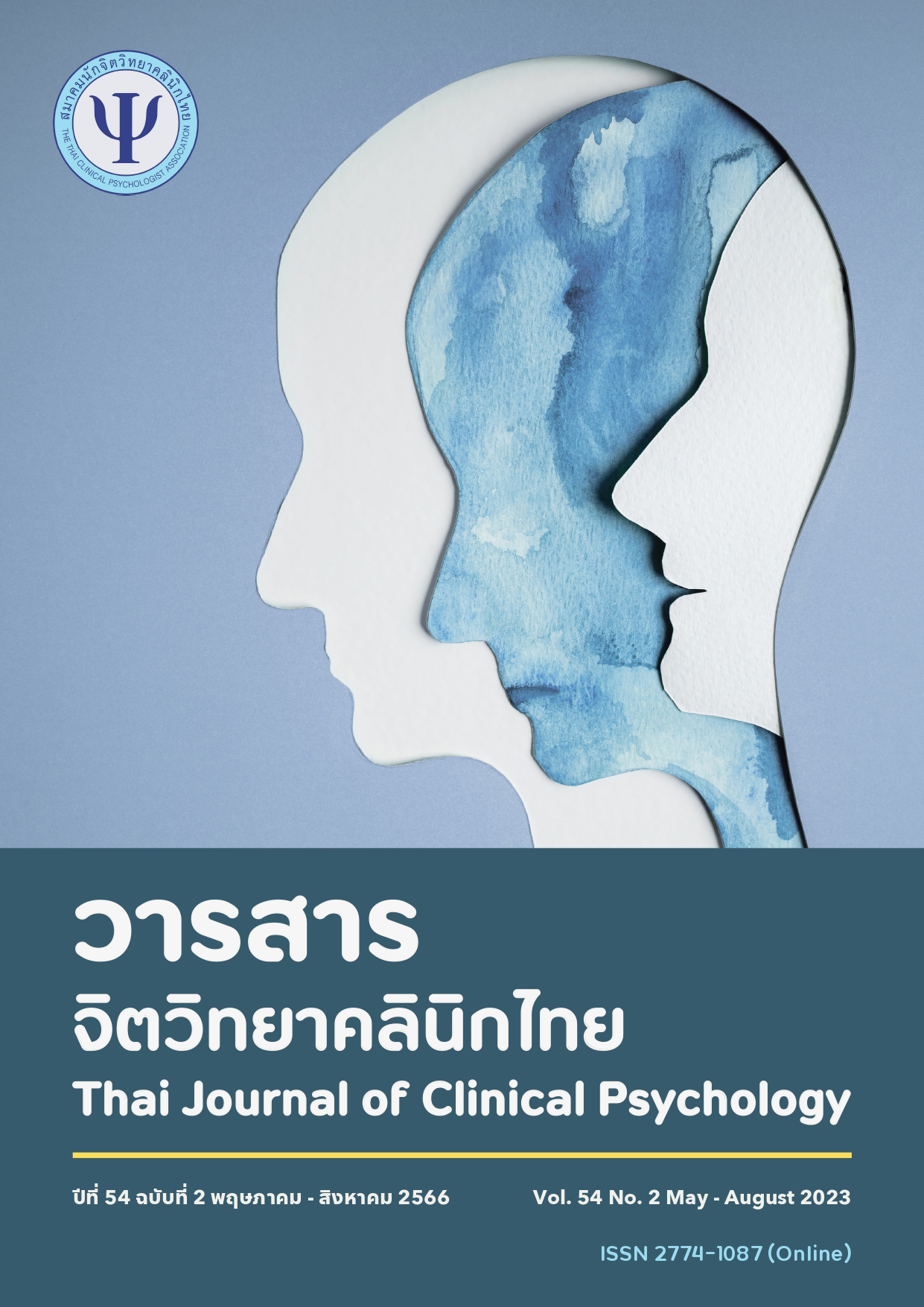การดื่มสุรากับอัตลักษณ์ความเป็นหญิงของนักศึกษา: การวิเคราะห์ปรากฏการณ์วิทยาเชิงตีความ
Main Article Content
บทคัดย่อ
วัตถุประสงค์ เพื่อศึกษาประสบการณ์การดื่มสุราของนักศึกษาหญิง และเพื่อศึกษาความเกี่ยวข้องกันระหว่างประสบการณ์การดื่มสุรากับอัตลักษณ์ความเป็นหญิง วัสดุและวิธีการ การวิจัยครั้งนี้เป็นการวิจัยเชิงคุณภาพแนวปรากฏการณ์วิทยาเชิงตีความ การเก็บข้อมูลใช้แบบสัมภาษณ์กี่งโครงสร้าง ผู้ให้ข้อมูลหลักเป็นนักศึกษาหญิงที่ศึกษาอยู่ระดับชั้นปริญญาตรีที่ดื่มสุราโดยเฉลี่ยไม่น้อยกว่า 1 ครั้งต่อสัปดาห์จำนวน 8 คน ผลการศึกษา วาทกรรมว่า “ผู้หญิงที่ดี” ทำให้นักศึกษาหญิงที่ดื่มสุราถูกเหมารวมและตีตราว่าเป็นหญิงที่ไม่ดี อย่างไรก็ตามพวกเธอไม่ยอมจำนนต่อวาทกรรมดังกล่าวโดยแสดงผ่านกระบวนการต่อรองต่อต้านระหว่างอัตลักษณ์ความเป็นหญิงกับการดื่ม
ของพวกเธอ ซึ่งจากข้อค้นพบดังกล่าวสามารถแสดงรายละเอียดได้ผ่านใจความสำคัญหลัก 2 ประการ คือ 1) ประสบการณ์การดื่มสุราภายใต้วาทกรรมความเป็นหญิงที่ดีและ 2) อัตลักษณ์ความเป็นหญิงกับการดื่มสุรา สรุป การดื่มสุราของนักศึกษาหญิงมีความเกี่ยวข้องกับบทบาทเพศหญิงและอัตลักษณ์ความเป็นหญิง การดำเนินการส่งเสริมป้องกันปัญหาจากการดื่มสุราในนักศึกษาหญิงควรให้ความสำคัญกับความละเอียดอ่อนทางเพศภาวะ
Article Details

อนุญาตภายใต้เงื่อนไข Creative Commons Attribution-NonCommercial-NoDerivatives 4.0 International License.
เรื่องที่ลงตีพิมพ์ในวารสารจิตวิทยาคลินิกแล้วถือเป็นลิขสิทธิ์การเผยแพร่โดยวารสารจิตวิทยาคลินิกแต่เพียงผู้เดียว การตีพิมพ์หรือเผยแพร่ซ้ำในที่อื่นต้องได้รับอนุญาตจากกองบรรณาธิการวารสารฯ
เอกสารอ้างอิง
Aekplakorn, W. (2022). National health examination survey VI, 2020-2021. Faculty of Medicine Ramathibodi Hospital, Mahidol University. (in Thai).
Apirukkraisri, P. (2022). Alcohol drinking patterns among Thai female workers. Journal of MCU Social Development, 7(1), 29-41. (in Thai).
Arnett, J. J. (2000). Emerging adulthood: A theory of development from the late teens through the twenties. American Psychologist, 55(5), 469-480. https://doi.org/10.1037/0003066X.55.5.469
Buasorn, R., & Ratchadapunnathikul, C. (2013). Consumption behavior alcoholic beverage consumption attitude Influence from media bachelor students. Ramathibodi Nursing Journal, 18(2), 259-271. (in Thai).
Center of Alcohol Studies. (2022). Patterns and tendencies of alcohol drinking behavior of the Thai population. (n.p.). https://shorturl.asia/Zqxcn. (in Thai).
Center of Behavioral Health Statistics and Quality. (2015). Behavioral health trends in the United States: Results from the 2014 national survey on drug use and health. HHS Publication, No.SMA 15-4927, NSDUH Series H-50.
Hutton, F., Griffin, C., Lyons, A., Niland, P., & McCreanor, T. (2016). “Tragic girls” and “crack whores”: Alcohol, femininity, and Facebook. Feminism & Psychology, 26(1), 73-93.
Jeennoon, P. (2017). The qualifications of “wellbehaved women” in Supasit Sorn Ying of the southern related to Buddhist notions and beliefs. Journal of Humanities and Social Sciences, 9(17), 160-175. (in Thai).
Kongon, C. (2017). Construction of social reality of women with broken families: Studied from national book award-winning novel. Journal of Communication and Management NIDA, 3(3), 40-48. (in Thai).
Lebreton, F., Robert, P., Jacquelyn, A., Lia, C. W., & Guillaume, R. (2017). Contextualizing students' alcohol use perceptions and practices within French culture: An analysis of gender and drinking among sport-science college students. Sex Roles, 76, 218-235.
Lekkla, N. (2021). Changes of discourse on gender and sexual diversity in sexuality education textbooks from perversion to acceptance under the concept of multiculturalism that is just a discourse. Journal of Language and Culture, 40(2), 79-95. (in Thai).
Mitchell, T. (2006). Intoxicated identities: Alcohol’s power in Mexican history and culture. New York: Routledge, 62(4), 674-675. https://doi.org/10.1017/S0003161500070073
National Statistical Office. (2021). The 2021 health behavior of population survey. National Statistical Office, Ministry of Digital Economy and Society. (in Thai).
Noomuen, W. (2009). Realistic novels: Modern “didactic” literature. Journal of Humanities and Social Sciences, 5(2), 71-105. (in Thai).
Patton, L. D., Renn, K. A., Guido, F. M., & Quaye, S. J. (2016). Student development in college. (3rd edition). Jossey-Bass, A Wiley Brand.
Phukao, D., Sakulsriprasert, C., Thawornwutichat, R., Kruahiran, P., Sa-ngasri, S., Kitcharoen, P., Chatsuphange, P., & Marohabutr. (2022). A surveillance of drinking behavior and implicit cognition among university students in Bangkok and Vicinity, Thailand. Faculty of Social Sciences and Humanities, Mahidol University. (in Thai).
Potikul, S., Phukao, D., Sakulsriprasert, C., Payakkakom, A., & Guadamuz, T. (2022). Development and validation of a conceptual model of femininity related intermediate beliefs about alcohol use among female undergraduate students. Kasetsart Journal of Social Sciences, 43(1),115-122.
Riemer, A. R., Gervais, S. J., Skorinko, J. L. M., Douglas, M. S., Spencer, H., Nugai, K., Karapanagou, A., & Miles-Novelo, A. (2019). She looks like she’d be an animal in bed: Dehumanization of drinking women in social contexts. Sex Roles, 80, 617-629. https://doi.org/10.1007/s11199-018-0958-9
Romo-Avilés, N., Marcos-Marcos, J., TarragonaCamacho, A., Gil-García, E., & Marquina-Márquez, A. (2016). “I like to be different from how I normally am”: Heavy alcohol consumption among female Spanish adolescents and the unsettling of traditional gender norms. Drug: Education, Prevention and Policy, 25(3), 262-272.
Sakulsriprasert, C. (2018). Identities, drinking identity and patterns of drinking narrating the drinking experience of life under the university boundary. In S. Chaoraineung (Ed.), Cultural research and health risks: Alcohol, tobacco. (pp.13-43). D-one Books Co., Ltd. (in Thai).
Sakulsriprasert, S., & Sakulsriprasert, C. (2018). Drinking motives and alcohol-related problem in university students: Modeling and testing model invariance across gender. Journal of Education, 19(2), 153-166. (in Thai).
Sherer, P. P., & Wongupparaj, P. (2005). Sociocultural dimension of alcohol use and domestic violence. Faculty of Social Science and Humanities, Mahidol University. https://repository.li.mahidol.ac.th/handle/123456789/21890
Sin-Amphol, P. (2017). “Space and time” in accessing alcoholic beverages among female university students in Chiang Mai province. Center of Alcohol Studies. https://shorturl.asia/hlfLD. (in Thai).
Smith, J. A. (2009). Interpretative phenomenological analysis: Theory, method, and research. Sage Publications.
Srichanil, C. (2019). Interpretative phenological analysis: Quality criteria. Journal of Human Sciences, 20(1), 189-213.
Vaadal, K. & Dahl, S. (2021). Maturing out of ‘binge drinking’: Young adult women’s performance of age and gender in times of transition. Journal of Youth Studies, 24(10), 1326-1339. https://doi.org/10.1080/13676261.2020.1828846
Visser, R. & Smith, J. (2007). Alcohol consumption and masculine identity among young men. Psychology & Health, 22(5), 595-614. https://doi.org/10.1080/14768320600941772
Young, A. M., Morales, M., McCabe, S. E., Boyd, C. J., & Darcy, H. (2005). Drinking like a guy: Frequent binge drinking among undergraduate women. Substance Use & Misuse, 40(2), 241-267. https://doi.org/10.1081/ja-200048464


